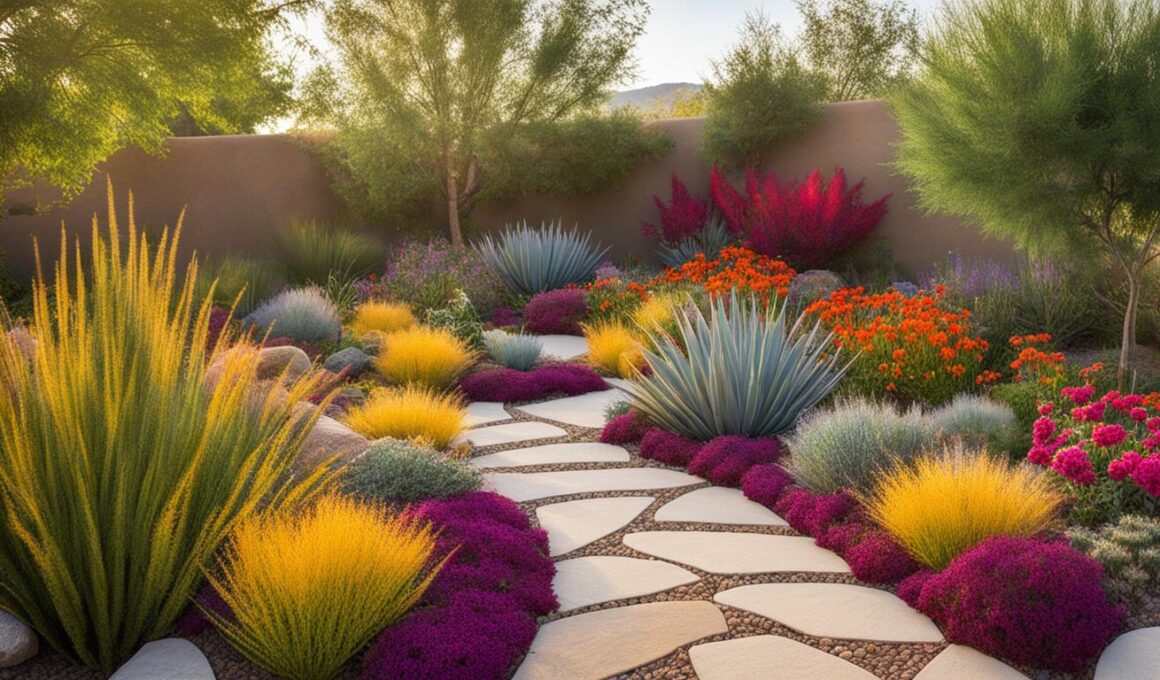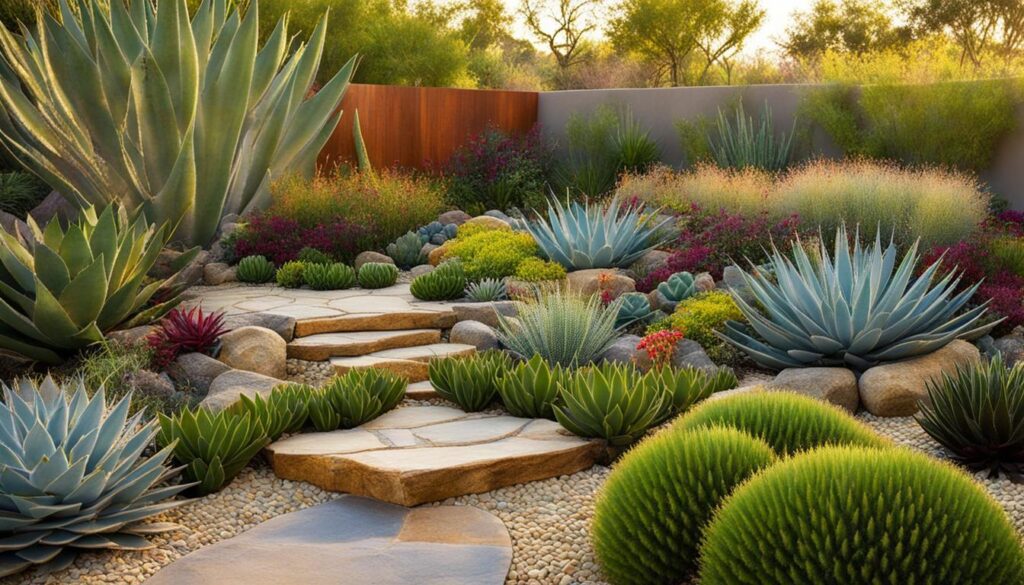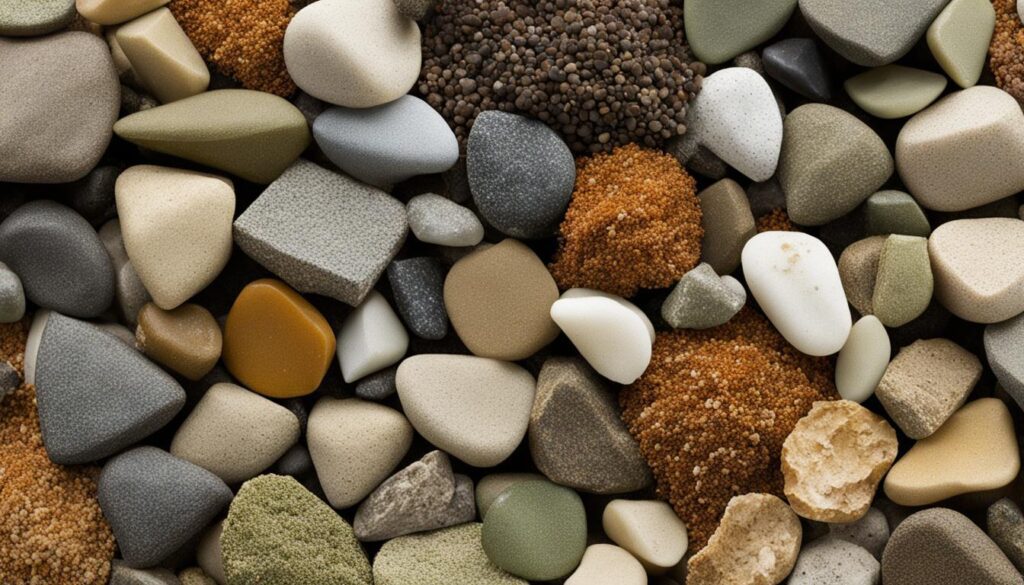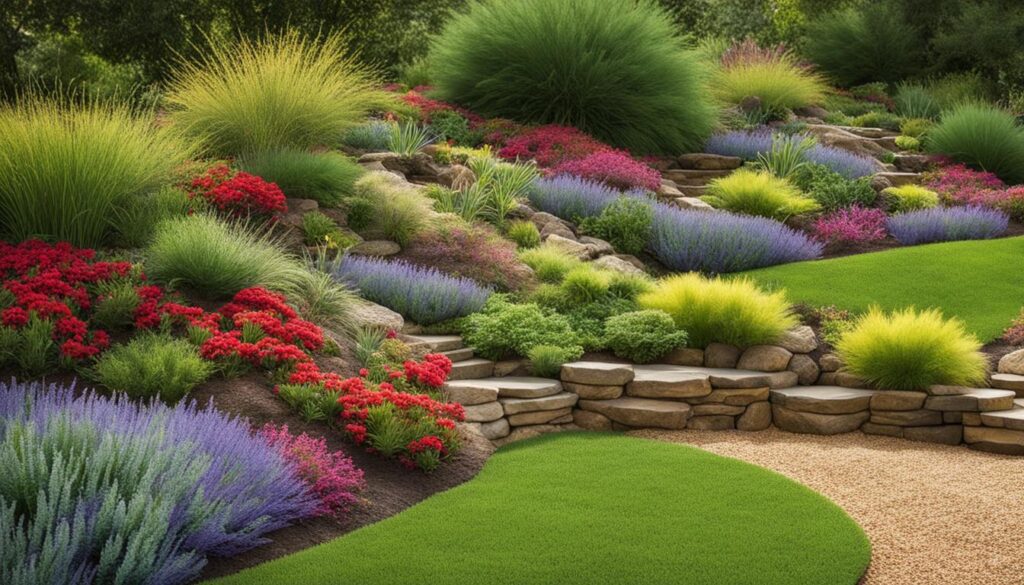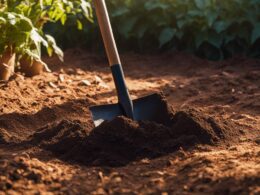Designing a drought-tolerant garden can help you save water and still enjoy a vibrant garden throughout the year. By implementing xeriscaping techniques and using drought-tolerant plants, you can create a beautiful and water-saving yard. This article will provide you with ideas and tips for creating your own drought-tolerant xeriscape garden layouts.
Key Takeaways:
- Drought-tolerant xeriscape garden layouts can help you save water and maintain a vibrant garden year-round.
- Replace thirsty grass with drought-tolerant perennials to create a water-wise and visually appealing front yard.
- Incorporate hardscape elements like walkways and gravel centers to add visual interest to your water-saving landscape.
- Utilize water features such as fountains that can capture and recycle water, enhancing your drought-tolerant garden.
- Choose drought-tolerant plants that provide structure, color, and don’t require much supplemental moisture to thrive.
Replace Thirsty Grass with Drought-Tolerant Perennials
Lawns are notorious for being heavy water users and can quickly become a burden on your water supply during a drought. However, there are alternative landscaping options that can reduce water consumption and still provide an attractive front yard. Consider replacing part of your thirsty grass with water-wise plantings and drought-tolerant perennials to create a more environmentally friendly and drought-tolerant landscape.
Choosing drought-tolerant perennials not only helps conserve water but also adds texture, color, and interest to your front yard. These hardy plants have adapted to survive in dry conditions, reducing the need for constant watering. Incorporating a variety of perennials with different bloom times can ensure your landscape stays vibrant throughout the year.
“By replacing thirsty grass with drought-tolerant perennials, you can create a front yard that not only looks beautiful but also helps save water during times of drought.”
Front yard landscaping with drought-tolerant perennials can transform your outdoor space into a showcase of sustainable gardening. From vibrant flowers to interesting foliage, these plants offer an array of options to suit your personal taste and style. With proper care and maintenance, your front yard can remain lush and appealing while conserving water and contributing to a more sustainable environment.
Incorporate Hardscape Elements for Visual Interest
When designing a water-saving landscape, don’t forget to incorporate hardscape elements to add visual interest to your garden. Walkways, gravel centers, and garden art can not only enhance the aesthetics of your outdoor space but also create focal points that draw the eye.
By carefully selecting drought-tolerant shrubs, evergreens, and groundcovers, you can create a lush-looking garden that requires minimal watering. These plants have adapted to thrive in dry conditions, making them perfect for a water-saving landscape. Additionally, drought-tolerant groundcovers can help catch rainwater runoff and reduce soil erosion.
Maximize Visual Impact
When planning your hardscape elements, consider maximizing visual impact by incorporating different textures, colors, and heights. Use smooth stones, pavers, or decorative tiles for walkways and patios to add interest and create a visual contrast with the surrounding plants. In smaller spaces, gravel centers can provide an attractive focal point and help reduce watering needs.
Finding the Right Balance
While hardscape elements can add beauty and structure to your water-saving landscape, it’s important to find the right balance between hardscape and greenery. Be mindful of your overall garden design and ensure that the hardscape elements complement and enhance the natural beauty of the drought-tolerant plants.
“Incorporating hardscape elements into your water-saving landscape not only adds visual interest but also reduces the need for excessive watering. It’s a win-win situation for both aesthetics and conservation.” – Landscaping expert
By incorporating hardscape elements into your drought-tolerant garden, you can create a visually stunning and sustainable outdoor space that requires less water. Embrace the beauty of hardscaping and drought-tolerant groundcovers to create an inviting and water-saving landscape.
Fountains in Drought-Tolerant Gardens: Enhancing Beauty and Sustainability
Incorporating a fountain into a drought-tolerant garden may seem counterintuitive, but it can actually be a stunning and water-saving addition. With careful design and planning, fountains can capture and recycle water, reducing waste and maximizing the overall sustainability of your outdoor space.
Not only do fountains provide a focal point and visual interest in your garden, but they can also enhance the cooling effect of surrounding groundcovers. By strategically placing showy foliage plants and groundcovers near the fountain, you can create a refreshing atmosphere in key areas of your yard.
Consider adding a small raised pond with a fountain as an unexpected element in your water-wise design. This can further promote water recycling and create a tranquil space for relaxation and enjoyment. With the right combination of water features and plantings, you can achieve a balance between beauty and sustainability in your drought-tolerant garden.
Benefits of Incorporating Fountains in Drought-Tolerant Gardens:
- Water recycling: Fountains can capture and recycle water, reducing water waste and promoting sustainability.
- Cooling effect: Surrounding groundcovers and foliage plants can enhance the cooling effect of the fountain, creating a refreshing atmosphere.
- Unexpected focal point: A small raised pond with a fountain can add visual interest and serve as a focal point in your water-wise yard.
- Tranquil space: The sound of trickling water and the presence of a fountain can create a serene and relaxing environment in your garden.
Incorporate Fountains for Beauty and Sustainability
With careful consideration of design and water-saving techniques, fountains can be a valuable addition to your drought-tolerant garden. They not only provide a visual focal point but also contribute to water recycling efforts and create a cooling effect through surrounding groundcovers. Embrace the beauty and functionality of fountains in your water-wise landscape to enhance both the aesthetics and sustainability of your outdoor space.
Choose Drought-Tolerant Plants for Structure and Color
When designing your drought-tolerant xeriscape garden, it’s crucial to select the right plants that can thrive in dry conditions while still providing structure and color. By choosing drought-tolerant plants, you ensure that your garden remains vibrant and visually appealing throughout the year.
An excellent choice for your drought-tolerant garden is to incorporate tough and colorful perennials. These plants are hardy and can withstand periods of drought without compromising their beauty. Consider options like lavender, yarrow, and coneflowers, which not only add vibrant colors but also attract beneficial pollinators to your garden.
In addition to perennials, incorporating evergreens into your garden provides structure, height, and year-round color. Evergreen shrubs and trees, such as junipers, boxwoods, and pine trees, create a visually pleasing backdrop for your garden. They also serve as a reliable anchor point, adding depth and structure to your landscape.
Creating a Diverse Plant Palette
- Include a mix of perennials and evergreens for a balanced look.
- Choose plants with varying heights to create visual interest.
- Consider plants with different leaf shapes and textures for added diversity.
“By carefully selecting a diverse array of drought-tolerant plants, you can create a visually stunning landscape that requires minimal water and maintenance.” – Landscaping Expert
Another way to add interest to your garden is by incorporating oversized boulders strategically. These natural elements not only provide focal points but also help fill gaps between plants, adding a touch of rugged beauty to your garden design.
Remember, when choosing drought-tolerant plants, it’s important to consider your specific region’s climate and soil conditions. Researching and selecting plants that are well-suited to your area will ensure the success and longevity of your drought-tolerant xeriscape garden.
Optimize Water Absorption with Porous Materials
When designing your drought-tolerant xeriscape garden, it’s crucial to consider ways to optimize water absorption and reduce water runoff. One effective strategy is to incorporate porous materials into your hardscape elements. Porous materials, such as permeable pavers or gravel, allow water to seep through and be absorbed by the soil instead of running off. This helps ensure that the water reaches your plants’ roots where it’s needed the most.
In addition to using porous materials for your walkways or patio areas, you can further enhance water absorption by adding a layer of mulch between your drought-tolerant plants. Mulch acts as a protective barrier, reducing water loss through evaporation and suppressing weed growth. It also helps to insulate the soil, keeping it cooler in hot weather and preventing moisture from evaporating too quickly.
When selecting plants for your xeriscape garden, consider choosing drought-tolerant varieties with gray or silver foliage. These plants often have adaptations that allow them to thrive in arid conditions and require less water. Their unique color and texture can also add visual interest to your garden, creating a striking contrast with other greenery. Examples of drought-tolerant plants with gray or silver foliage include lavender, agave, sage, and artemisia.
Benefits of Using Porous Materials in Your Garden:
- Enhanced water absorption and reduced runoff
- Improved soil health and moisture retention
- Protection against weed growth and soil erosion
- Lower maintenance and water requirements
“Using porous materials in your xeriscape garden not only helps conserve water but also promotes a healthier and more sustainable landscape.”
By incorporating porous materials, optimizing water absorption, and selecting drought-tolerant plants with gray or silver foliage, you can create a visually appealing and water-efficient garden. Embrace the beauty of a xeriscape garden that not only saves water but also thrives in dry conditions.
What are the Best Plant Choices for a Drought-Tolerant Xeriscape Garden?
When creating a drought-tolerant xeriscape garden, it’s important to choose plants that thrive with minimal water. Some great choices include succulents like agave and yucca, as well as lavender, Russian sage, and ornamental grasses. These watersaving features in xeriscape gardens help conserve water and maintain a beautiful landscape.
Tiered Garden Bed: An Effective Solution for Managing Water Runoff
Managing water runoff on steep slopes can be a challenge for many gardeners. The steep terrain makes it difficult for water to penetrate the soil, leading to erosion and the loss of valuable moisture. However, by implementing a tiered garden bed system, you can effectively reduce water runoff and create a more sustainable and beautiful garden.
A tiered garden bed consists of multiple levels or terraces that are built into the slope. These terraces help to slow down the flow of water and allow it to gradually seep into the soil, reducing erosion and preventing water runoff. By creating a series of stepped planting areas, you can take advantage of the natural incline of the slope while maximizing water absorption and minimizing soil erosion.
To construct a tiered garden bed, start by digging out each level into the slope, making sure to create a sturdy retaining wall to hold the soil in place. Choose plants that are suitable for the specific conditions of each level, considering their water requirements and ability to tolerate the slope. By selecting drought-tolerant plants, you can further reduce the need for frequent watering and create a more sustainable garden.
Remember to establish a watering schedule for your plants to ensure they receive adequate moisture without wasting water. Watering early in the morning or late in the day is most effective, as it reduces evaporation and allows the plants to absorb water before the heat of the day. Additionally, consider incorporating a drip irrigation system or installing rainwater collection barrels to further optimize water usage in your tiered garden bed.
Key Points:
- A tiered garden bed is an effective solution for managing water runoff on steep slopes.
- By creating multiple levels or terraces, water flow is slowed down, allowing for better absorption into the soil.
- Choose drought-tolerant plants that can thrive in the specific conditions of each level.
- Establish a watering schedule and consider implementing drip irrigation or rainwater collection systems.
Conclusion
Creating a drought-tolerant xeriscape garden layout not only helps you save water but also allows you to enjoy a beautiful and vibrant garden throughout the year. By replacing thirsty grass with drought-tolerant perennials, incorporating hardscape elements, utilizing water features, choosing drought-tolerant plants, optimizing water absorption with porous materials, managing water runoff, and creating seating areas, you can create a stunning and sustainable outdoor space. Embrace the beauty of drought-tolerant landscaping and start designing your own xeriscape garden layouts today.





